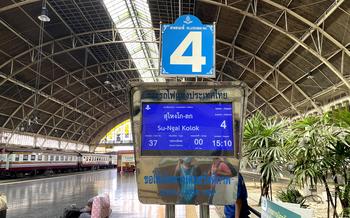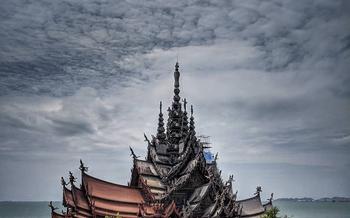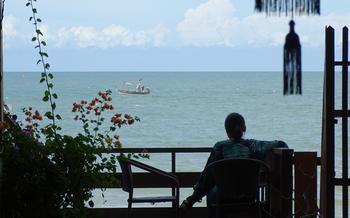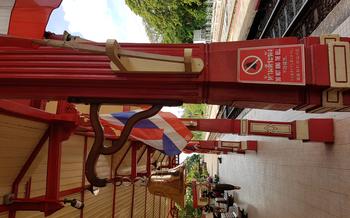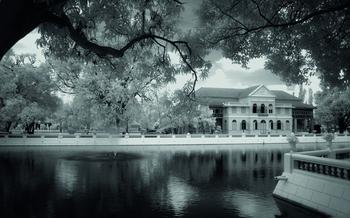
Nakhon Si Thammarat Clock Tower
- Atop the South:
- Nakhon's Timekeeper
- A Royal Commission:
- A Blend of Styles
- Four Faces, One Purpose
- Atop the City
- A City's Transformation
- The Bell Tower's Voice
- A Symbol of Resilience
- A Touch of Royalty
- A Work of Art
- Preserving the Past
- Insider Tip:
Atop the South:
The Nakhon Si Thammarat Clock Tower stands tall, a majestic sentinel guarding the southern reaches of Thailand. Its historical significance is deeply intertwined with the city's rich past, serving as a testament to the architectural prowess and cultural heritage of Nakhon Si Thammarat.
The clock tower's architectural features are a blend of Eastern and Western influences, creating a distinctive landmark that is both aesthetically pleasing and historically significant. Its four clocks, each facing a different direction, symbolize the unity and diversity of the city. The observation deck atop the tower offers breathtaking panoramic views of Nakhon Si Thammarat, making it a popular destination for both locals and tourists.
As a symbol of the city, the Nakhon Si Thammarat Clock Tower has become an iconic representation of Nakhon Si Thammarat's identity. Its presence in the heart of the city serves as a reminder of the rich history, cultural heritage, and progress that Nakhon Si Thammarat has witnessed over the years.
Nakhon's Timekeeper
The history of the clock tower is closely intertwined with the origins and development of Nakhon Si Thammarat. In the late 19th century, during the reign of King Rama V, a royal commission was established to modernize and develop the city. As part of this initiative, the construction of a clock tower was proposed to serve as a symbol of progress and a timekeeping device for the growing urban population. The tower's design and construction were overseen by skilled Thai artisans who incorporated both Eastern and Western architectural elements to create a unique and iconic landmark.
The original purpose of the clock tower was primarily functional. Its four clocks, facing different directions, provided accurate timekeeping for the city's residents and visitors. The tower also served as a meeting point and a gathering place, where people could come together for social interactions and community events. Over time, the clock tower gained cultural significance, becoming a symbol of Nakhon Si Thammarat's progress and modernization. It represented the city's commitment to embracing new ideas and technologies while preserving its rich cultural heritage.
A Royal Commission:
King Rama V, also known as Chulalongkorn, played a pivotal role in the construction of the Nakhon Si Thammarat Clock Tower. Recognizing the importance of infrastructure and urban development, he initiated several projects aimed at modernizing and improving the city. The clock tower was one such initiative, envisioned as a symbol of progress and a representation of the city's growing status.
Under the king's patronage, the construction of the clock tower commenced, with the primary objective of enhancing the city's infrastructure and promoting its development. The clock tower served as a focal point for urban planning, attracting businesses and residents to the surrounding area. It also played a crucial role in improving the city's transportation system, as roads and streets were constructed to connect to the clock tower, facilitating easier movement and access.
A Blend of Styles
The Nakhon Si Thammarat Clock Tower stands as a testament to the harmonious fusion of Eastern and Western architectural styles. Its design reflects the city's rich cultural heritage, blending traditional Thai elements with European influences. The result is a unique and captivating structure that embodies the city's unique identity.
The Eastern influences are evident in the tower's intricate details and ornamentation. The roof, for example, features a traditional Thai-style gable adorned with intricate carvings and colorful tiles. The four corners of the tower are adorned with mythical creatures, known as chofas, which symbolize protection and good fortune.
In contrast, the Western influences are reflected in the tower's overall structure and design. The use of arches, columns, and pediments gives the tower a distinctly European feel. The clock faces themselves are a clear indication of Western influence, as they display Roman numerals and are set within ornate metal frames.
Despite the contrasting styles, the tower's design is remarkably cohesive. The Eastern and Western elements blend seamlessly to create a harmonious and visually pleasing whole. This fusion of styles is a testament to the skill and creativity of the architects and builders who created this iconic landmark.
Four Faces, One Purpose
The four clocks on the Nakhon Si Thammarat Clock Tower hold deep symbolic meaning, representing the four cardinal directions: north, south, east, and west. Each clock face tells the time accurately and precisely, emphasizing the importance of punctuality and precision in daily life. Together, the four clocks symbolize the unity and harmony of different directions, cultures, and perspectives, coming together to create a cohesive and vibrant city. This harmonious integration of diverse elements reflects the rich cultural heritage of Nakhon Si Thammarat, where people from different backgrounds coexist peacefully and contribute to the city's unique identity.
Atop the City
The Nakhon Si Thammarat Clock Tower stands tall in the heart of the city, offering breathtaking panoramic views from its observation deck. Visitors can ascend to the top of the tower to witness the city's vibrant tapestry from above. The observation deck provides a 360-degree vista, allowing visitors to admire the city's landmarks, temples, and bustling streets. The views are especially captivating during sunrise and sunset, when the city is bathed in a golden glow. The clock tower's elevated position also makes it an ideal spot for photography enthusiasts to capture stunning shots of the cityscape.
A City's Transformation
The Nakhon Si Thammarat Clock Tower played a pivotal role in the development of Nakhon Si Thammarat. Its construction marked a turning point in the city's history, ushering in an era of progress and modernization. The clock tower became a symbol of urban growth, attracting people from surrounding areas to settle in the city. This influx of population led to the expansion of the city limits and the development of new infrastructure, such as roads, schools, and hospitals. The clock tower acted as a catalyst for the city's economic growth, as it attracted businesses and investments. Today, Nakhon Si Thammarat is a thriving city with a strong economy and a rich cultural heritage. The clock tower stands as a testament to the city's transformation from a small town to a bustling metropolis.
The Bell Tower's Voice
The Nakhon Si Thammarat Clock Tower is not just a visual spectacle but also an auditory one. Its unique bell, housed within the tower's structure, chimes with a distinct and resonant tone that echoes through the streets of the city, adding a layer of charm and authenticity to the landmark. The bell's sound is a familiar rhythm in the lives of Nakhon residents, marking the passage of time and serving as a reminder of the city's rich history and cultural heritage. Locals and visitors alike find solace in the bell's melodious chimes, which evoke a sense of nostalgia and a connection to the city's past.
A Symbol of Resilience
Nakhon Si Thammarat Clock Tower has endured the relentless passage of time, standing steadfast through turbulent wars and devastating natural disasters. Its resilience is a testament to the indomitable spirit of the city and its people. Despite the ravages of war and the fury of nature, the clock tower has emerged unscathed, its structure intact and its spirit unbroken.
Like a sentinel guarding the city, the clock tower has borne witness to countless historical events, from the rise and fall of kingdoms to the struggles for independence. Through it all, the clock tower has remained a constant, a symbol of strength and resilience in the face of adversity. Its endurance is a testament to the indomitable spirit of the people of Nakhon Si Thammarat, who have rebuilt and renewed their city time and again, rising like a phoenix from the ashes of destruction.
A Touch of Royalty
The Nakhon Si Thammarat Clock Tower holds a special place in the hearts of the local people due to its royal connections. Throughout history, members of the Thai royal family have visited the clock tower, paying their respects and acknowledging its significance as a symbol of the city. These visits not only reinforce the cultural and historical importance of the clock tower but also serve as a reminder of Nakhon Si Thammarat's deep-rooted royal heritage. The presence of royalty at the clock tower adds an air of grandeur and reverence, further enhancing its status as a beloved landmark.
A Work of Art
The Nakhon Si Thammarat Clock Tower stands as a testament to the skill and artistry of Thai craftsmen. Its intricate details and craftsmanship are a sight to behold, making it a true work of art. The tower's design incorporates both Eastern and Western architectural elements, creating a unique and harmonious blend. The result is a visually stunning structure that is both aesthetically pleasing and historically significant.
The clock tower's intricate carvings and embellishments showcase the artistry and attention to detail that went into its construction. The tower's four faces feature elaborate carvings depicting scenes from Thai mythology and history, while the interior of the tower is adorned with beautiful murals and paintings. The clock tower's intricate details and craftsmanship make it a true work of art, a masterpiece that has stood the test of time and continues to captivate visitors with its beauty and grandeur.
Preserving the Past
The Nakhon Si Thammarat Clock Tower stands as a testament to the city's rich history and cultural heritage. Recognizing its significance, the local authorities and the community have made concerted efforts to maintain and restore this iconic landmark. Regular maintenance and restoration work are carried out to ensure the structural integrity and beauty of the clock tower are preserved for future generations.
The preservation of the clock tower goes beyond physical upkeep. It also involves the preservation of its cultural significance and the stories it holds. The local community takes pride in the clock tower and actively participates in events and initiatives aimed at promoting its history and heritage. By doing so, they ensure that the clock tower remains not just a physical structure but a living symbol of Nakhon Si Thammarat's identity and cultural legacy.
Insider Tip:
For a truly unforgettable experience, plan your visit to coincide with one of the many events or festivals held at the clock tower. These events showcase the vibrant culture and traditions of Nakhon Si Thammarat and offer a unique opportunity to immerse yourself in the local way of life. From traditional dance performances and music concerts to food fairs and cultural exhibitions, there's something for everyone to enjoy.
After exploring the clock tower, take some time to wander through the surrounding area. Discover hidden gems such as charming cafes, quaint shops, and historic temples. Ask the locals for recommendations on where to eat and what to see, as they'll be more than happy to share their favorite spots with you. With so much to offer, the Nakhon Si Thammarat Clock Tower is a must-visit destination for anyone seeking a glimpse into the heart and soul of this vibrant city.

